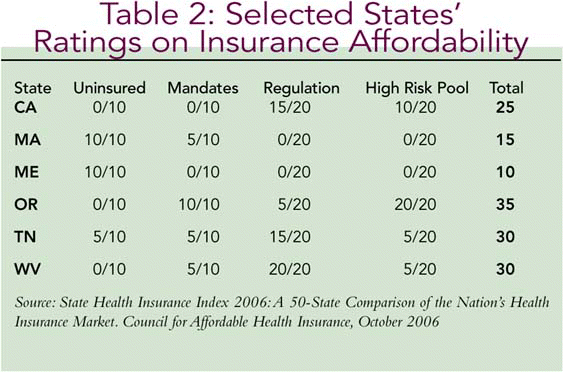CAHI’s ratings (see Table 2) are based on the number of state mandates; state regulatory environments, particularly regarding guaranteed issue and community rating; and whether the state has well-functioning high-risk pools that act as a safety net for individuals with pre-existing medical conditions. The score listed in the table is the number of points out of the maximum-e.g., 15 out of 20 possible points in a given area.
Explore This Issue
May 2007While activity heats up in state legislatures, ENToday focuses here on four states currently gaining much attention for their plans to cover the uninsured.
Massachusetts
In 2005, Massachusetts’ Democrat-controlled legislature and Republican Governor Mitt Romney devised a radical plan to be implemented in July 2007 ensuring that all state residents have health insurance. The plan would try to enroll the state’s 100,000 Medicaid-eligible citizens, subsidize anyone below the federal poverty level (FPL) of $9800, and penalize individuals and small businesses failing to purchase coverage through a state-sanctioned insurance pool.
Of interest to other state lawmakers is the pay or play feature: employers with 100 or fewer employees will pay a 5% payroll tax and those with 100 or more employees a 7% payroll tax if they do not make insurance available to their employees. Starting in tax year 2007, Massachusetts residents who cannot prove they have health insurance will be penalized on their tax returns. The plan’s cost is estimated at $1.6 billion, most of it already available from existing state and federal funds.
The small business lobby went along with the plan because of the Connector, a new state agency linking employers and individuals with insurers that offer affordable products that include all of Massachusetts’ 40 mandated benefits (including in vitro fertilization, mental health, and bone marrow transplants).
Then there was a hitch. Initial bids for monthly premiums submitted by major insurers to the Connector were $380 per month, versus the $200 suggested in the original legislation. The Connector rejected $380 as unaffordable, and recently 10 major insurers agreed to offer plans for $175 per month ($109 if purchased with pretax dollars). Insurers are allowed to set copays, deductibles, and other out-of-pocket expenses.
Massachusetts’ plan for universal coverage piqued the interest of other governors, especially Arnold Schwarzenegger of California. Vermont’s plan is similar in that employers that currently do not provide coverage will either have to purchase it or pay fees. Jerry Geisel, a senior writer at Business Insurance, calls Massachusetts’ plan a logical approach. If the state has to subsidize people to get them to take care of health problems sooner rather than later, that avoids costly ER and hospitalizations down the road. The plan’s central concept, to provide appropriate solutions for different classes of uninsured people-enroll the Medicaid-eligible individuals in that program, subsidize the working poor into attractive competitive insurance plans, and require everyone else to buy insurance or pay a tax penalty-makes theoretical sense. But memories of Michael Dukakis’ Massachusetts Miracle of 1988, an employer-driven mandate for health insurance, which failed, come to mind. And it’s unclear how major insurers, including Blue Cross/Blue Shield of Massachusetts, Fallon Community Health Plan, Tufts Health Plan, and Harvard Pilgrim, could quickly drop their premium bids from $380 to $175.

Leave a Reply